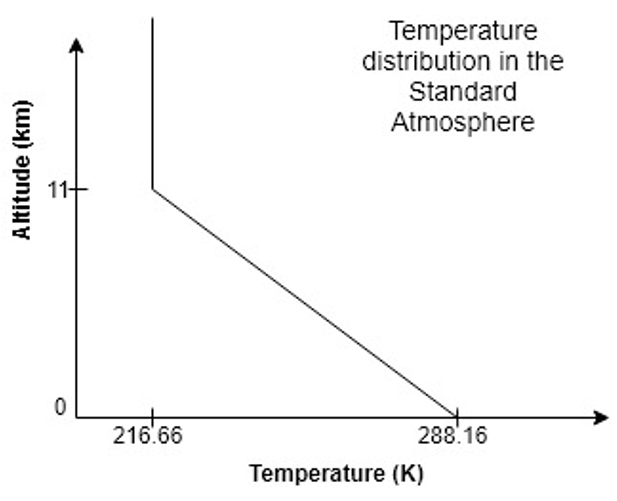This set of Spaceflight Mechanics Multiple Choice Questions & Answers (MCQs) focuses on “Standard Atmosphere”.
1. Earth’s consists mainly of molecular Nitrogen and Oxygen in proportions of ________________ respectively.
a) 25% and 70%
b) 78% and 21%
c) 21% and 78%
d) 70% and 25%
View Answer
Explanation: Earth’s atmosphere contains about 78% Nitrogen and 21% Oxygen. It also has other gases such as 0.97% Argon and 0.03% Carbon dioxide/Water
2. Earth’s atmosphere is divided into 5 layers based on temperature gradients.
a) True
b) False
View Answer
Explanation: The atmosphere is divided into exosphere, thermosphere, mesosphere, stratosphere and troposphere, 5 layers, based on temperature gradients.
3. Most weather effects that are experienced on Earth are experienced in which layer of the earth’s atmosphere?
a) Stratosphere
b) Mesosphere
c) Troposphere
d) Exosphere
View Answer
Explanation: Troposphere is where most of the weather phenomena occur. This layer is situated between the mean sea level and 18 km above mean sea level if the tropopause is included.
4. The standard atmosphere temperature at a geopotential altitude of 12 km is 216.65 K. What is the standard atmosphere temperature at a geopotential altitude of 13 km?
a) 210.11 K
b) 250.71 K
c) 202.01 K
d) 216.65 K
View Answer
Explanation: The standard atmosphere temperature will remain the same between geopotential altitudes of 12 km and 13 km since both heights are a part of the tropopause which is an isothermal layer of our atmosphere. Therefore, the answer is 216.65 K, the same as at 12 km.
5. Most of the ozone layer exists in the mesosphere layer.
a) True
b) False
View Answer
Explanation: Ozone exists mostly in the stratosphere layer. Stratosphere is situated between 20 to 50 km above mean sea level. Ozone layers absorbs 97 to 99 percent of the harmful ultraviolet light coming from the sun.
6. What will be the acceleration due to gravity at 300 kms above MSL, assuming the gravity at MSL is 9.81 m/s2 and the radius of Earth is 6378 km?
a) 99% of gravity at MSL
b) 95.5% of gravity at MSL
c) 93.2% of gravity at MSL
d) 90% of gravity at MSL
View Answer
Explanation: Given,
Gravity at MSL (g0) = 9.81 m/s2
Geopotential altitude (h) = 300 km
Radius of earth (RE) = 6378 km
Gravity at 300 km above MSL (g) = g0.(RE/(RE + h))2
= 9.81*(6378/(6378+300))2
= 9.718 m/s2
Percentage = (9.718/9.81) x 100% = 95.5% of MSL gravity
7. What is the geopotential altitude for a geometric altitude of 100 km above MSL? Given, radius of earth is 6378 km.
a) 100 km
b) 102.3 km
c) 107.2 km
d) 98.46 km
View Answer
Explanation: Given,
Geometric altitude (hg) = 100 km
Radius of earth (RE) = 6378 km
Geopotential altitude (h) = (RE / (RE + hg)). hg
= (6378/(6378+100))*(100)
= 98.46 km
8. The temperature gradient for stratosphere is 0.001 K/m. Assuming the temperature at 20 km above MSL is 216.65 K, what is the temperature at 32 km above MSL?
a) 250.17 K
b) 215.68 K
c) 228.65 K
d) 202.12 K
View Answer
Explanation: Given,
Temperature gradient (a) = 0.001 K/m = 1 K/km
At point 1, h1 = 20 km, T1 = 216.65 K
At point 2, h2 = 32 km, T2 =?
T2 = a.(h2 – h1) + T1
= 1*(32-20) + 216.65
= 228.65 K
9. What is the standard atmosphere value of pressure at geopotential altitude of 9 km? Given, Universal gas constant is 287 J/kg, pressure at MSL is 1.01 x 105 Pa and gravity at MSL is 9.81 m/s2. All the other information required is provided in the diagram below.

a) 22.52 kPa
b) 33.673 kPa
c) 30.626 kPa
d) 29.77 kPa
View Answer
Explanation: Given,
At point 1 (MSL), T1 = 288.16 K, h1 = 0
At point 2, T2 = 216.66 K, h2 = 11 km
Temperature gradient (a) = (T2 – T1) / (h2 – h1)
= (216.66 – 288.16)/(11 – 0)
= -6.5 K/km
Universal gas constant (R) = 287 J/kg
Gravity at MSL (g0) = 9.81 m/s2
Pressure at MSL (p1) = 1.01 x 105 Pa
Temperature at 9 km (T) = a.(h – h1) + T1
= -6.5*(9-0) + 288.16
= 229.66 K
Now, using isentropic relations, we can find pressure at 9 km (p)
p = p1.(T/T1)^(-g0/(aR))
= (1.01*105)*(229.66/288.16)^(-9.81/(-0.0065 x 287))
= 30.626 kPa
10. What is the density of air at a geopotential altitude of 11 km if the pressure and temperature at that altitude are 22.7 kPa and 216.66 K respectively? Given, density, pressure and temperature at MSL is 1.225 kg/m3, 101325 Pa and 288.16 K respectively.
a) 0.252 kg/m3
b) 0.146 kg/m3
c) 1.365 kg/m3
d) 0.365 kg/m3
View Answer
Explanation: Given,
At MSL, Temperature (T1) = 288.16 K
Pressure (p1) = 101325 Pa
Density (ρ1) = 1.225 kg/m3
At 11 km, Temperature (T) = 216.66 K
Pressure (p) = 22700 Pa
Density (ρ) =?
From the equation of state,
p/p1 = (ρT)/(ρ1/T1)
ρ = (pρ1T1)/(p1T)
= (22700*1.225*288.16)/(101325*216.66)
= 0.365 kg/m3
Sanfoundry Global Education & Learning Series – Spaceflight Mechanics.
To practice all areas of Spaceflight Mechanics, here is complete set of 1000+ Multiple Choice Questions and Answers.
If you find a mistake in question / option / answer, kindly take a screenshot and email to [email protected]
